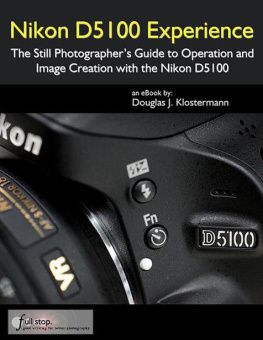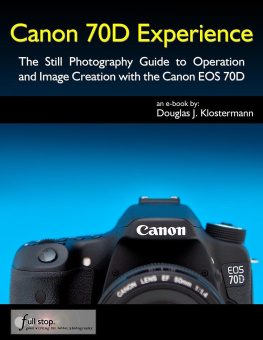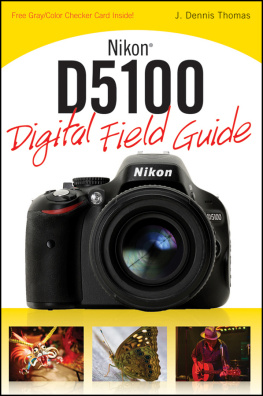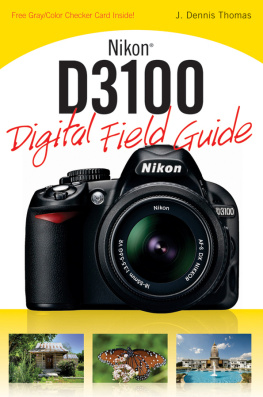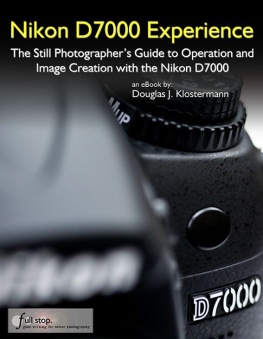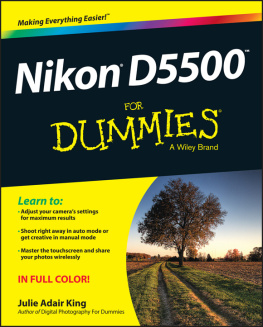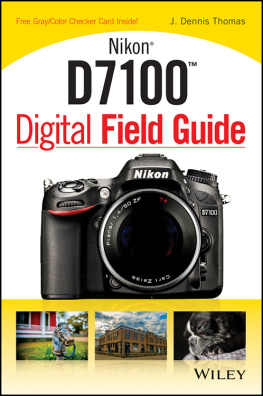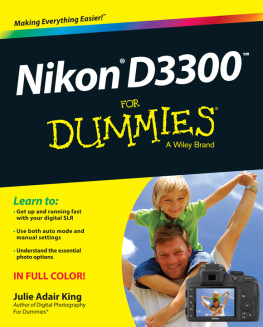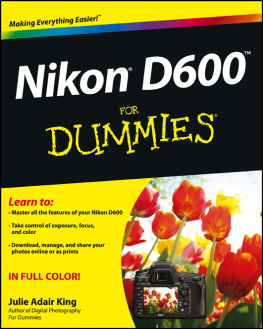
Nikon D5100 Experience
The Still Photographers Guide to
Operation and Image Creation
with the Nikon D5100
By: Douglas J. Klostermann
Full Stop. good writing for better photography
All rights reserved. No part of this book may be reproduced or transmitted in any form or by any means, electronically or in print, without expressed permission from the author. The author takes no responsibility for the use of any of the materials or methods described in this book, or for the products, Internet web sites, or links mentioned. Douglas Klostermann is a participant in the Amazon Services LLC Associates Program, an affiliate advertising program designed to provide a means for sites to earn advertising fees by advertising and linking to amazon.com.
All contents including cover design, text, and photographs
Copyright 2011 Douglas J. Klostermann
Nikon D5100 Experience
The Still Photographers Guide to Operation and Image Creation with the Nikon D5100
by: Douglas J. Klostermann
Kindle Version 1.1
May 2011
www.dojoklo.com
Authors blog: http://blog.dojoklo.com/
Published by Full Stop. good writing for better photography
A division of Douglas J. Klostermann Photography
Cambridge, MA 02138 USA
http://www.dojoklo.com/Full_Stop/
CONTENTS
INTRODUCTION
The introduction of the Nikon D5100 brings forth a worthy successor to its popular predecessor, the D5000. By incorporating the high quality 16.2 megapixel sensor, great low-light performance, and full HD video of the pro-sumer D7000, the D5100 puts these advanced features in the hands of the dedicated enthusiast, plus includes a fully adjustable high resolution rotating LCD screen. With its 420 pixel RGB exposure metering sensor, accurate 11 point autofocus system, 4 frames per second continuous shooting speed, and easy to navigate information display, the D5100 offers the capability and features required for dedicated photographers who wish to continue to grow.
The Nikon D5100 is clearly an advanced tool for digital photography, and offers the potential to capture professional quality images in most any situation you wish to use it. But it is merely a tool.

Figure 1 Detail of the Nikon D5100 digital SLR
It is up to you to make use of its features and capabilities to create the images you envision. While the cameras manuals can tell you about the settings and controls and how they function, this guide will build upon that and tell you when and why you want to use them. Every button, menu item, and Custom Setting of the D5100 is there for a reason: to help you capture the images you want. Some of them are more useful to different types of photographers and shooting situations and you dont need to learn and use them all immediately, but this guide should help to give you the knowledge to confidently use the ones that turn your Nikon D5100 into an image capturing tool that works best for you.
There are many different ways to use a digital SLR (dSLR) camera and its controls to capture images, and Im not going to attempt to explain them all. I am going to concentrate on the ways that I believe are the most practical, useful, and effective. The settings and techniques I discuss apply to general photography, which includes most travel photography. I will point out other options for users who might wish to work differently and I encourage you to experiment and find the techniques that work best and are most comfortable or intuitive for you. If you typically shoot very specifically, say macro photography or studio photography with complex lighting, some of what I discuss may not apply. But if you are that specialized, Im sure you are skilled enough to know when and how to adapt what I say!
Since this guide is intended to help you get the most out of your D5100, I will not necessarily discuss or go into detail about many of the automatic features or Auto and Scene Modes. The D5100 is a sophisticated tool that deserves to be used to its full potential, and that means taking control of the camera and its functions. And since this guide is about image creation the capturing of a photograph it will not discuss features that deal with image processing, such as the Retouch Menu. And finally, while it will discuss basic video settings and options to get you started, the guide will focus on still photography and image creation. However there is a great deal to be learned about everything else including the autofocus system, the elements of exposure, exposure metering, white balance, and even basic composition.
As you have probably discovered by now, the cameras Users Manual is brief and basic. There is a more detailed Reference Manual on the Reference CD included with your camera. This ebook guide will expand on the manuals and explain not only the features, controls, and menus of the D5100, but more importantly when and why you might want to use them in your photography. However, this guide is not intended to completely replace the manuals, but to be used in conjunction with them, so every bit of information in those manuals will not be repeated here. For example, I may explain the use of Single-servo AF (AF-S auto-focus mode), but not always explain how to change to this setting on your camera. If you dont know how to change it please read the Users Manual where it will tell you to press the i Button twice, highlight the focus-mode options, press OK, and then choose the AF-S focus mode.
As you can see, there is a lot to make sense of regarding terminology and controls, so I recommend that you familiarize yourself with the controls and displays of the camera body, as shown on pages 2-7 of the D5100 Users Manual and pages 1-10 of the D5100 Reference Manual (see Figure 2 ), as well as read through the manuals and attempt to understand as much as possible. Yes, much of it may be complicated and confusing at first, but this ebook guide will explain the uses of the numerous buttons, controls, menus, and settings and concentrate on the essential ones to get you started taking great images.

Figure 2 Controls on the top of the D5100
The majority of your settings can be changed with the i Button and Information Display (see Figure 3 ). Press the i Button once to view your settings, and a second time to enable you to navigate to a specific setting with the Multi Controller and access its options by pressing the OK Button. However, some settings of the Nikon D5100 can be controlled in multiple ways including using the buttons and controls on the camera body while reading the settings on the rear LCD Monitor, or accessing the settings in the Menus after pressing the Menu Button. Explore the options and find the ways that work most quickly and intuitively for you.
Any time I capitalize something in the text, it is a proper term that can be looked up in the Nikon D5100 manuals. I will capitalize the names of actual buttons, controls, camera parts, and menu items, such as Delete Button, Command Dial, Monitor, and Format. Again, please review the camera body and display diagrams in your D5100 manuals to familiarize yourself with the names of various parts, controls, and displays, as I will use these proper names in this text. The Nikon D5100 Reference Manual from the CD can also be downloaded in PDF format from the Nikon website here: http://support.nikonusa.com/app/answers/detail/a_id/17325 . Words and phrases that are capitalized and bold refer to chapters and sections within this guide. Turn on the bookmarks navigation or contents panel in your PDF viewer or e-reader to quickly navigate to these different sections.
Next page
